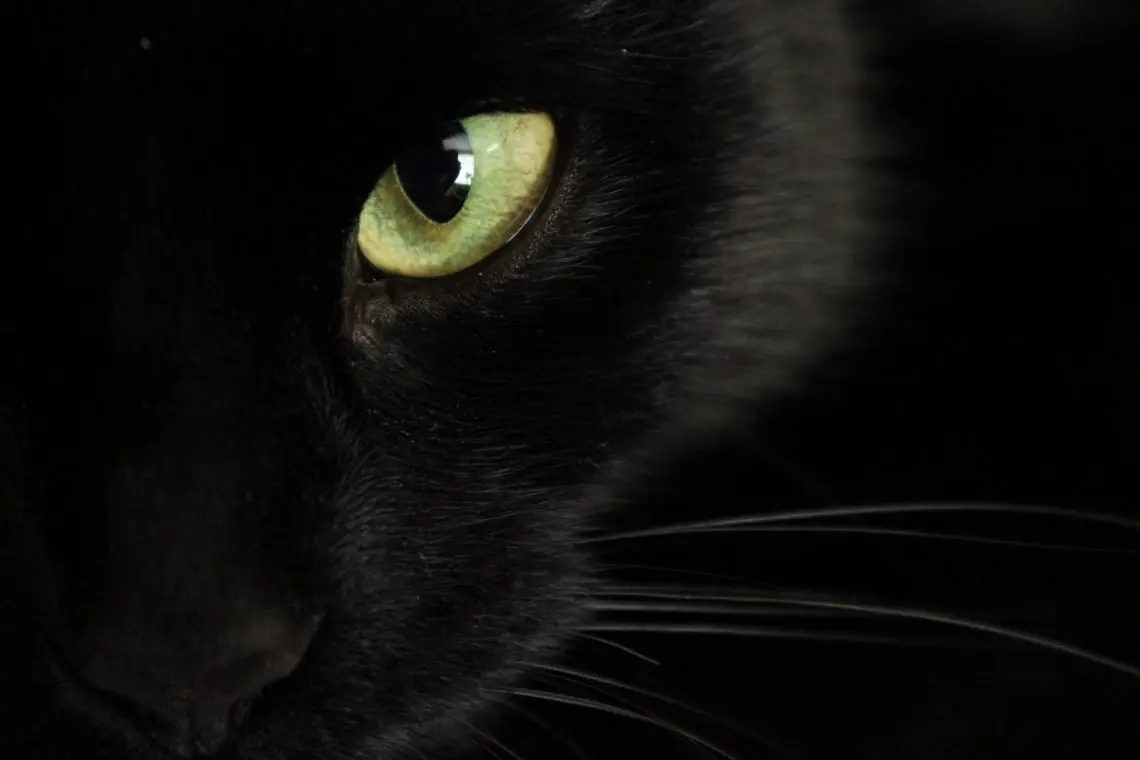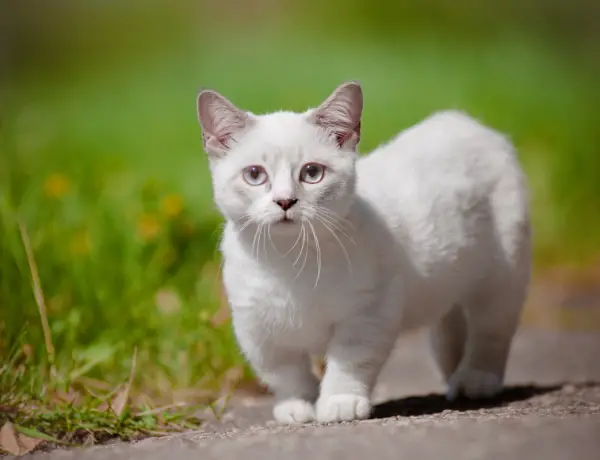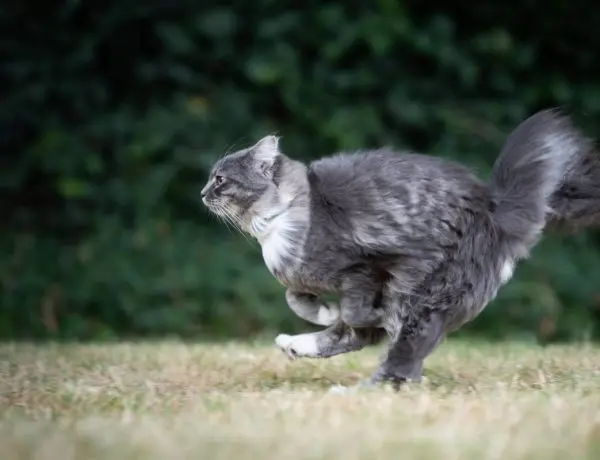We have all seen cats devour many things from chicken to ordinary houseplants, from bugs to rodents. However, people often wonder whether cats are naturally carnivores, herbivores, or omnivores, given the variety they have been known to display in their diets.
Cats fall under the category of carnivores. Moreover, they are specifically viewed as obligate carnivores. All cats are strictly obligate carnivores. What this means is that they must consume meat in order to survive and to maintain their internal biological systems.
Cats get their necessary nutrients from consuming meat. While you might think that cats would be classified as an omnivore, because they will at times eat plants, rice, cookies, or other foods, instead of just meat, they are still considered carnivores. While cats may eat plants or other non-meat items at times, there are no naturally vegan cats. Certain predatory instincts, physical traits, and biological requirements dictate that all cats are carnivorous and will have to consume meat in order to survive.
Table of Contents
What Makes Cats Obligate Carnivores?
It is likely that you have seen cats munch on fruits, vegetables, and other plants in adorable videos online. However, what you may not know is that cats cannot survive on plants alone. Cats may be able to eat and consume flora, but they must prey on fauna in order to survive. This is why cats are categorized as “Obligate Carnivores.”
Obligate carnivores are those carnivores that HAVE to rely on consuming other animals to meet their minimum nutritional requirements. These animals also come with a higher need for protein, and their digestive systems cannot efficiently process fruits and plants to extract most required nutrients. Cats are among the most notable species that belong to this category.
The word “obligate” emphasizes that it is necessary for those carnivores to prey on other animals to survive. These carnivores cannot survive on plants even if they do eat them. They must feed on other animals in order to get the right amount of nutrients required to prevent malnutrition and, ultimately, death.
Like most living things, cats require a specific combination of nutrients to survive and maintain a healthy life cycle (or nine life cycles!). Some of these chemical substances may be quite complex in terms of composition, while others can be very basic and simple. Later in this article, I will talk more about what precisely these vital substances are. These things need to be supplied to the cats at all times.
Cats can naturally produce some of the needed vitamins and amino acids themselves. However, there are many substances that felines’ bodies cannot produce on their own because they can only be extracted from foreign elements they consume, such as small rodents or other sources of meat.
For an example, all mammals require Vitamin C for their bodies to function correctly. Dogs can easily produce a high amount of this vitamin inside their bodies.
On the other hand, humans cannot. This is why doctors recommend that we get enough fruits in our diet or take sufficient amounts of supplements in order to provide our bodies with an appropriate amount of Vitamin C.
Similarly, cats need to provide a wide array of chemical substances to their bodies to carry on their life-sustaining processes, which is why they NEED to prey on other animals and eat meat to get the required amount of nutrients. Therefore, they are known as obligate carnivores.
What Are Carnivores?
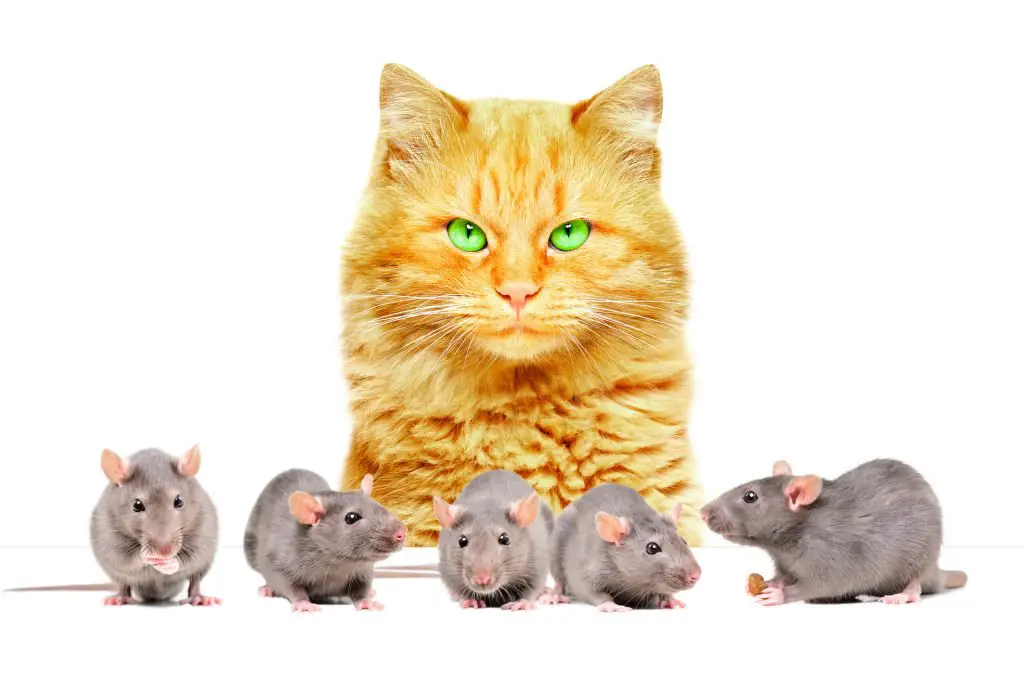
Animals that only eat meat are called carnivores. With a strong jaw and sharp teeth, carnivores tend to feed on other animals, such as herbivores and omnivores. Carnivores may eat insects, animals, birds, rodents, and other carnivores as well.
Carnivores are crucial to the survival of any ecosystem, as they monitor and control the production of other animals, and keep the numbers in check. For example, lions and other predators are responsible for controlling the population of other animals in jungles and forests. Without these carnivores present, herbivores would grow in number too quickly, and the ecosystem will swiftly snap out of balance.
While most people may think of a tyrannosaurus when they hear the word carnivore, they can actually come in a variety of sizes.
Large-sized carnivores include animals such as lions, tigers, wolves, and leopards, etc. These large-sized carnivores hunt down other animals, such as herbivores, and keep their population in check.
Secondly, there are medium-sizes carnivores such as snakes, eagles, and vultures. The primary source of nutrients for these carnivores is rodents, eggs, birds, and small prey.
Lastly, there are small-sized carnivores such as small birds, frogs, toads, etc. These carnivores eat insects, worms, and other smaller birds and their eggs.
Carnivorous species typically have strong jaws and powerful teeth that help take down the prey and tear off the meat from their bones. These carnivores may also have long, sharp claws that are used to tear their food as well.
Carnivores rely on an adequate supply of prey in the food chain to provide them with the food they need. If the number of herbivores or of other omnivores starts to decrease in an environment, carnivores cannot thrive or survive.
What Are the Carnivorous Characteristics of Cats?
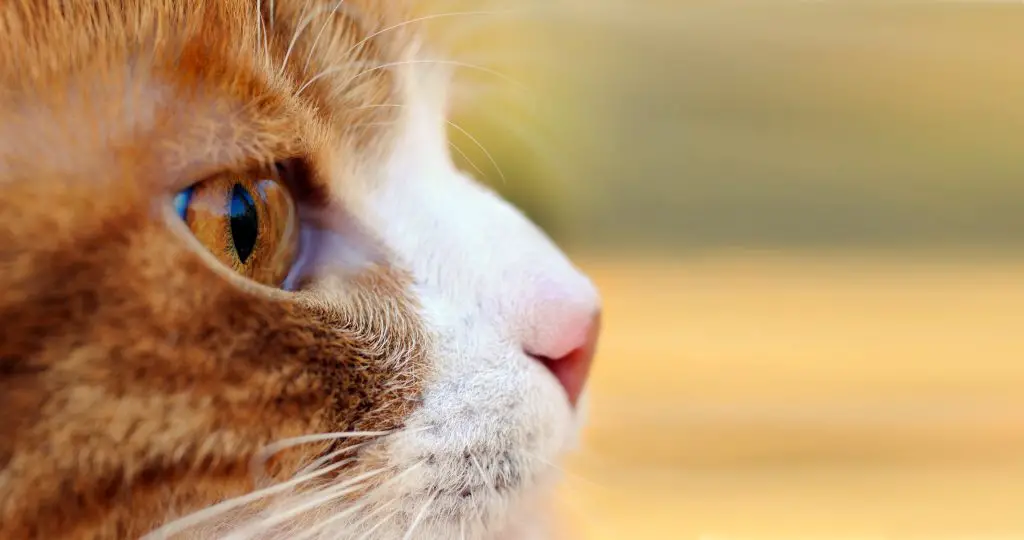
Let’s take a look at some of the characteristics of cats, to better understand what makes them carnivores.
Cats Have Predator-like Eyesight
According to researches conducted by scientists, it has been proven that house cats can easily see in the dark and locate their prey. This is a trait most commonly found among other predators, such as:
- Lions
- Tigers
- Cheetahs
- Puma
- Owls
This superior eyesight helps them locate the prey and keep track of its movements regardless of the surrounding environment.
Cats Have a Heightened Sense of Smell
Cats, like other predators, have a heightened sense of smell. If you have a pet cat, you must have observed that they seem to pop out of nowhere when you are about to eat food or have dinner. This is because they can smell food from far away and easily track its source with their keen sense of smell.
Cats Possess Strong Predatory Instincts
Like all the other predators, cats like to stalk and chase their prey. We all know about the cat’s fascination with mice. Domestic cats like to stalk these mice, pounce on them, and then take them around to show everyone their hunt.
Moreover, their paw pads are ideal and perfect for silently stalking prey during a hunt. With these paws, they can sneak up on their prey and hunt it without ever worrying about announcing their presence. These soft paws, combined with flexible leg joints, also help them land from immense heights without getting injured. This is yet another trait most commonly found among large-sized predators, such as tigers, leopards, and pumas.
Cats Possess Sharp Claws and Teeth
Cats are known to possess retractable claws that offer good traction. These sharp claws help hunt and catch prey with a strong grip as well as climb if the situation warrants. If you have seen a cat hunt its prey, you may have seen them attack its prey with their sharp claws. These claws are commonly found among other predators that hunt prey.
Felines also have a set of sharp teeth that can effortlessly slice, gnaw, piece, or rip and tear their prey’s flesh. Cats can rip open their prey with just one bite. The crown shape of cat teeth and the upper canines, also known as fangs, are a good indication that cats are truly meant to be carnivores.
Cats Have Vertical Plane Jaws
If you take a closer look at a cat’s jaws, you will see that the jaws open vertically, and don’t allow much flexibility to move in a circular or horizontal motion. A vertical pane jaw helps carnivores apply more pressure on their prey and rip into its flesh with the help of intense force.
Cats Have Strong Stomach Acids
Humans are known to have strong stomach acids that help us digest everything from meat to plants and salads. In the same way, cats also have strong stomach acids with dissolving capabilities. These acids are used for eliminating harmful bacteria on meat, and consume it without worrying about getting an infection or an easily upset stomach.
Moreover, these stomach acids help dissolve the meat and extract the required nutrients, such as:
- Carbohydrates
- Vitamins
- Proteins
- Fatty Acids
These strong acids are only ever found in omnivores or carnivores.
Cats Have a Short Digestive Tract
Why is a short digestive tract important? Well, a short digestive tract can help reduce digestive time. This short digestive tract and minimal digestive time also ensure that harmful bacteria’s opportunity to colonize within the body is reduced significantly. This is yet another physical trait most common with large and medium-sized carnivores.
What is in Cat Food?
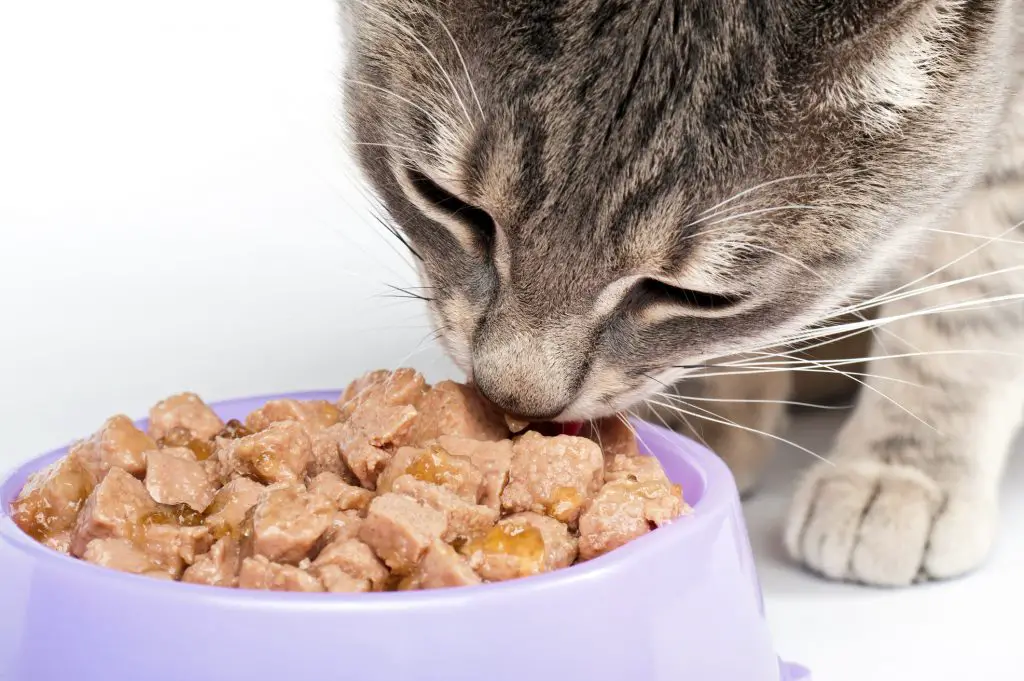
Humans love their pets, and cats are among the most loved pets and animals in the entire fauna kingdom. Pharaohs were known to make tombs and statues for their cats. Historically, it can be easy to see that cats have always occupied a special place in people’s hearts and lives.
This is precisely why the majority of people wouldn’t let their cats rely on hunted food alone. Therefore, people buy cat food from companies to feed their cats. So, what is in that cat food?
In short, these commercial cat food products contain animal products with vegetable-based starches. These starches are typically only used to hold the food together in its shape. The actual nutrients come from the animal products and fats contained within the food.
The majority of good modern pet food companies use the following types of meat to produce food for your beloved cat, whether that food comes in a bag or a can:
- Fish meat
- Poultry meat
- Chicken meat
On the other hand, some companies care more about profit than your kitty’s health. They will try to save money and use a high amount of carbohydrates in the food they produce. This can be quite dangerous to your pet’s health, as they will not get the nutrients needed in order to live healthily. Remember, cats MUST eat meat to survive! Be sure to check the label before deciding on the food you purchase for your cat.
What Else Do Cats Eat?
Some people have seen cats consume grass and houseplants every once in a while. This goes to show that cats can and do eat flora, but their bodies cannot correctly process it enough to get the required nutrients from such a diet. These plants merely provide them with enough fiber to aid with their internal digestion.
Cats can also eat some vegetables in small amounts, including:
- Carrots
- Potatoes
- Broccoli
While not harmful for them to have certain vegetables on occasion, you should remember that there is no such thing as a vegan cat. These items merely assist felines internal digestive processes in digesting the meat, and should not be given to them regularly.
What Is the Best Diet for Cats?
A cat’s diet must contain meat and fats. Too many fruits, vegetables, and carbohydrates will interfere with their natural digestive processes. As I mentioned earlier, well-made cat food will primarily consist of meat. While there will be some starches or other compounds therein, to assist with holding the shape of the food or preserving it better, they should be kept at a minimum.
Can A Cat Be Vegan?
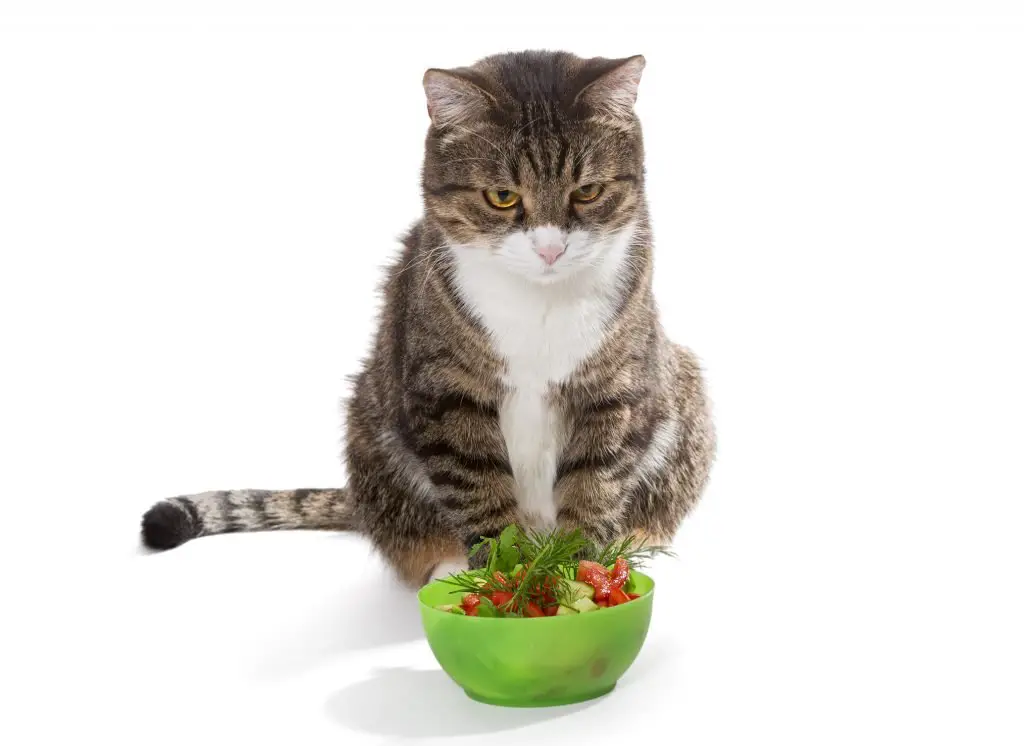
If someone tries to offer a completely vegan diet to their kitty, they will harm the animal and risk its life. The cat will likely develop a taurine deficiency because it will not be getting enough amino acids from a vegan diet. Subsequently, cats with a vegan diet will start developing severe conditions, such as:
- Dilated cardiomyopathy
- Skin conditions
- Heart conditions
- Malnutrition
- White discharge from their eyes
What Nutrients Do Cats Get from Meat?
Now, you know that cats are obligate carnivores and require vital nutrients from meat. However, what nutrients do they get from meat? Some substances can be produced within the body, but cats need to get the following nutrients from consuming meat:
- Vitamin A
- Niacin (Vitamin B)
- Arginine
- Taurine
- Felinine
- Dietary Protein
- Arachidonic Acid
Can Cats Go Without Eating?
You need to understand that you cannot put the cat on a starvation diet if your cat is fat. It is not healthy for a cat to fast and go without consuming food. If you need to have your cat slim down, reduction of caloric intake, and an increase in exercise is far more healthy. Fitness is essential for any living being. Without physical fitness, mammals tend to become lethargic, and eventually get wiped out by other animals or predators.
The biological processes of felines do not mobilize fat reserves for energy. Therefore, they must regularly obtain the appropriate amount of energy needed from food. If cats do not eat food for extended periods, their bodies will start breaking down and digesting non-fatty body tissues for energy, such as muscles and tissue. This can result in a severe feline disorder called hepatic lipidosis.
Cats must receive energy from their diet regularly, and any form of starvation will upset their internal functions and subsequently interfere with the processes inside their bodies.
What Are Herbivores and Omnivores?
Our beautiful planet offers a complex ecosystem that is host to a wide variety of living things. All of these creatures have their own biological and neurological processes that differ from one another.
The different and specific diets link all animals and beings together and offer them a unique place in the food chain. There are primarily three different types of living beings: carnivores, herbivores, and omnivores. We already know what carnivores are. Let’s take a look at the remaining categories.
What Are Herbivores?
Herbivores rely on plants for their nutrients and food and are often quite large given their diet routine. While the majority of people may believe that predators should be larger, it is often the herbivores who are the larger of the two. Examples of herbivores include:
- Cows
- Elk
- Sheep
- Goats
- Buffalo
- Camels
- Giraffes
Herbivores rely on eating grass, tree barks, herbs, shrubs, plants, flowers, and other forms of flora.
What Are Omnivores?
Omnivores will devour anything that is edible and crosses their path. From meat to plants, from bones to grass, these animals are capable of digesting just about everything, and their digestive systems can extract the required nutrients from a wide variety of foods. However, you need to understand omnivores may not be able to digest all the plants that herbivores can. Still, omnivores have the most diverse diets among all animals.
Humans and bears are examples of large omnivores. They can eat meat, as well as fruits and vegetables. Raccoons are among the medium-sized omnivores as they can eat fruits as well as small rodents. Fish and some species of insects are considered omnivores as they also rely on meat and fruits.
Final Thoughts
Cats are obligate carnivores and must rely on meat to acquire the appropriate amount of nutrients to sustain themselves in a healthy manner. Cats exhibit predatory traits most commonly found among other predators. Their internal processes require amino acids, fatty acids, and other nutrients that can only be obtained from a diet consisting of meat.

